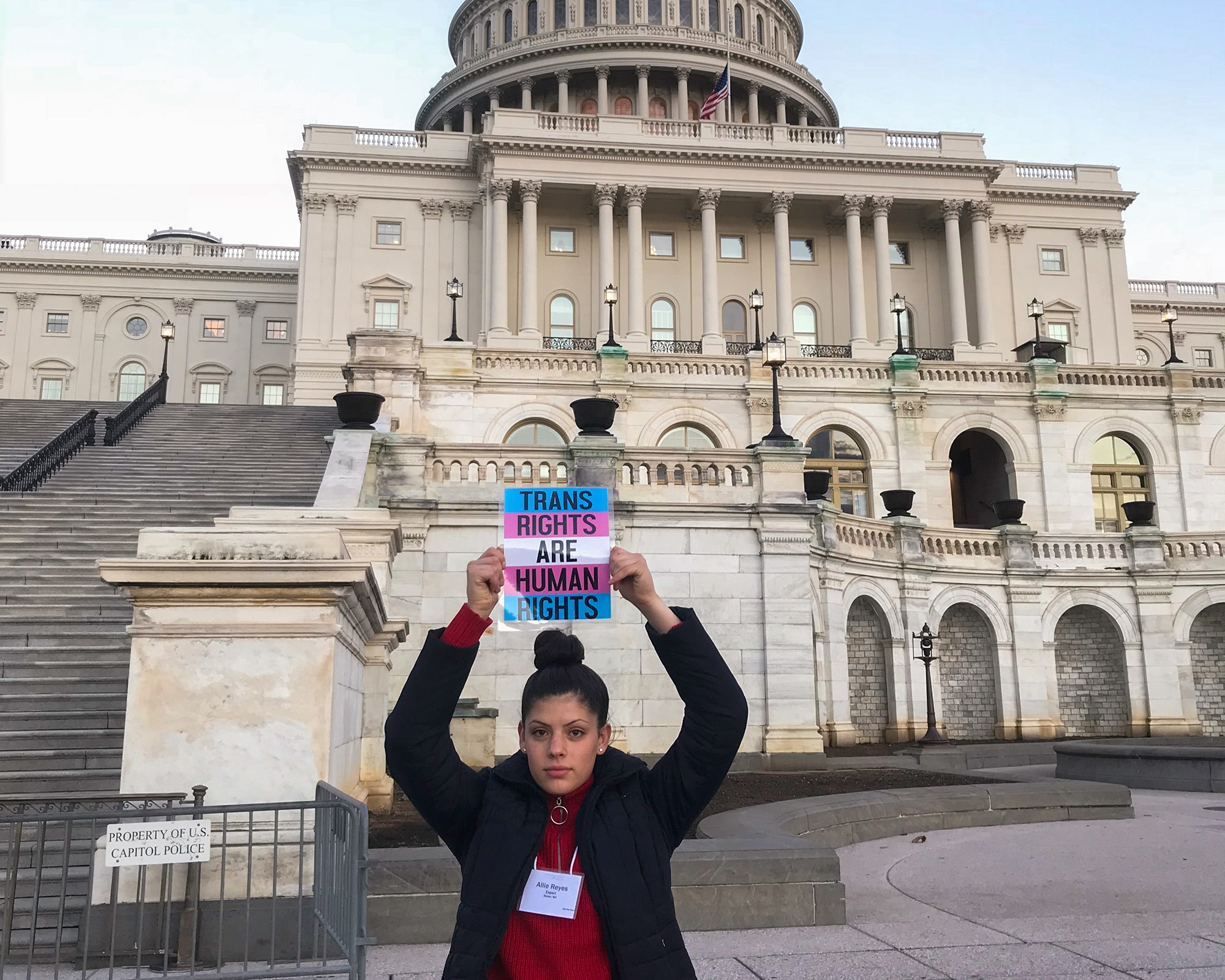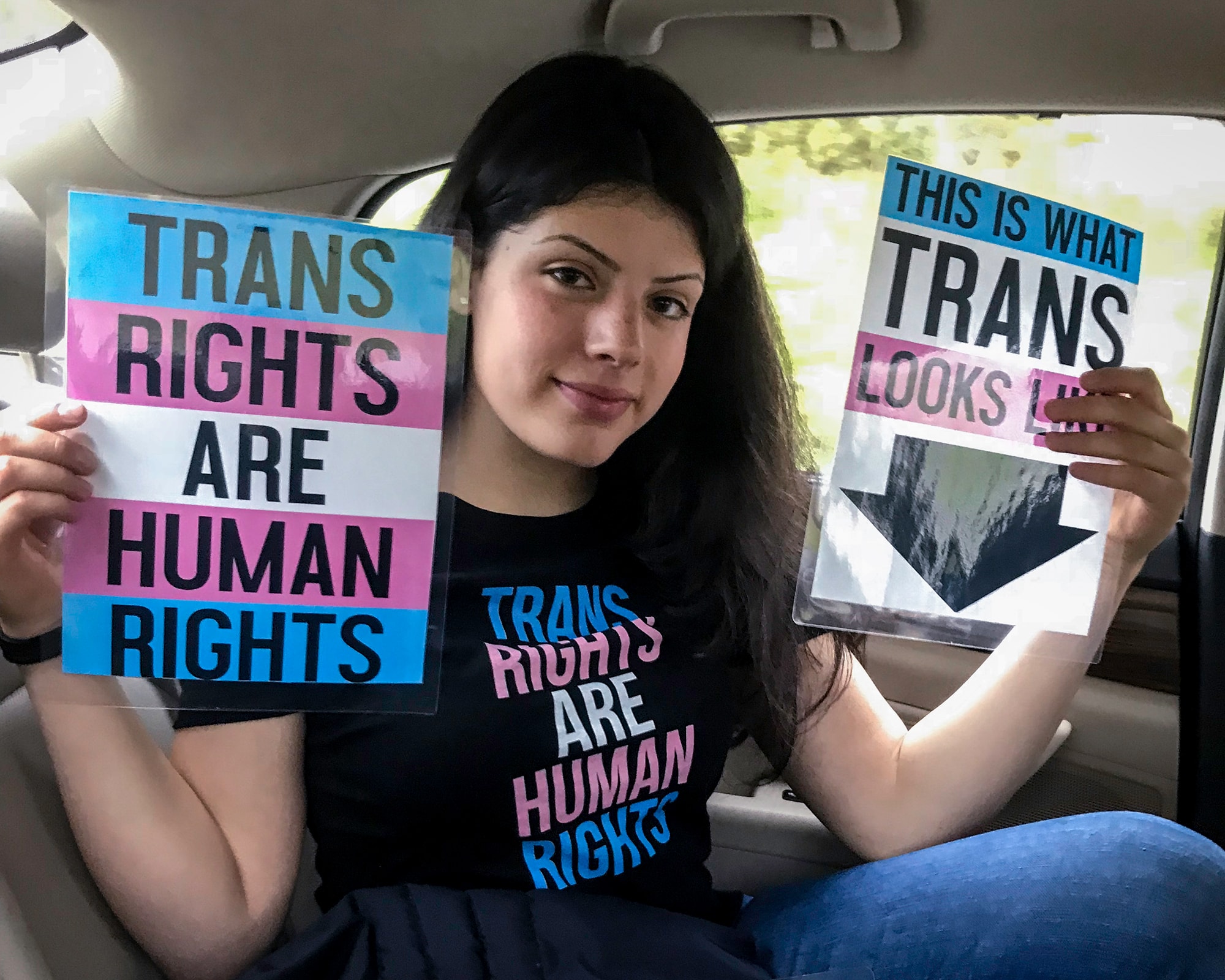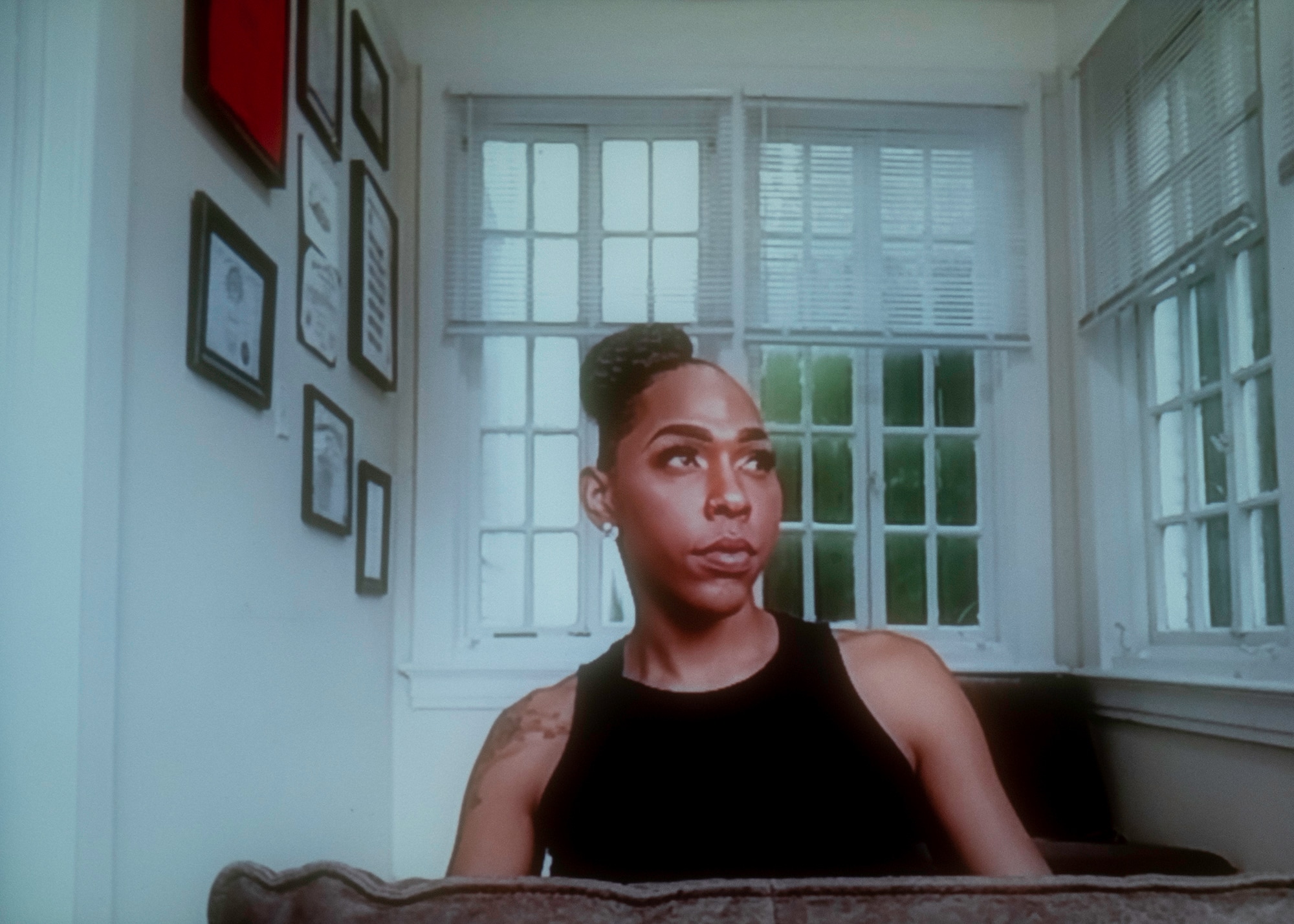(Photo courtesy of Aliyah, last name withheld)
Like all the bedrooms at the Sununu Youth Services Center in New Hampshire, the room where 15-year-old Allie Reyes slept had cinder block walls and a wooden door that locked at night from the outside.
On her first night, Reyes cried, but not from isolation or because she had a black eye from being jumped that day. She cried because her bedroom was on a separate floor, far from the girls’ unit where she spent her days – isolated because she was transgender.
“When I first got there, I was immediately retraumatized … my gender was invalidated,” Reyes recalled.

Allie Reyes in her room in Dover, New Hampshire. Reyes, who is transgender, was arrested in 2015 after a fight with her mom, who petitioned to transfer her daughter’s care to the state, Reyes says, because of their poor relationship. (Portrait taken remotely by Michele Abercrombie / News21)
That was in 2015. Since then, officials at Sununu say it has changed significantly. It is one of many facilities across the country facing increasing pressure to change the way they accommodate LGBTQ youth.
Because of vague and inconsistent regulations, the experiences of lesbian, gay, bisexual, transgender and intersex young people in the juvenile justice system vary dramatically across the country.
Up to 20% of youth in the juvenile justice system identify as LGBTQ, compared with 4% to 6% of the general youth population. The majority of LGBTQ youth in detention are kids of color.
Experts say transgender and gender-nonconforming kids are especially at risk of ill-treatment because they challenge social expectations of masculinity and femininity. Very few states protect gender identity under statute law for youth in the justice system.
Even in places where transgender youth are technically protected by law, individual facilities still interpret legislation inconsistently, resulting in unreliable care, said Shannan Wilber, the youth policy director for the National Center for Lesbian Rights.
Truancy, homelessness and “survival crimes” committed by LGBTQ youth can push them into the juvenile justice system, Wilber said.
“LGBTQ youth, like all youth, basically need a sense of belonging to develop and successfully transition to adulthood,” Wilber said. “And what happens for a lot of queer and trans youth is they don’t have that.”
Wilber likened the process to a revolving door as LGBTQ kids cycle through juvenile justice, group homes, foster care and other outposts of child welfare systems.
“It’s kind of a crapshoot which system’s going to catch you first,” Wilber said.
Loopholes in state laws – and no statutes protecting sexual orientation or gender identity in 46 states – can leave LGBTQ young people with minimal security, unreliable medical care and a higher risk for sexual assault.


At a 2018 conference in Washington, D.C., hosted by the American Institutes for Research, Allie Reyes spoke about health care accessibility for young people aging out of juvenile care, as well as for transgender people. “Being selected and knowing that my voice was valued … it was like a real taste of it,” Reyes says. “It was through the power of my network that I got all these opportunities and the ability to tell my story.” (Photos courtesy of Allie Reyes)
Reyes was arrested in 2015 for simple assault during a fight with her mom, who filed a petition to transfer her daughter’s care to the state because of their fractured relationship.
Before she was incarcerated, Reyes wrote a letter to her judge begging not to be sent to Sununu because she’d heard stories of transgender people being harrassed in correctional facilities. But because the state could not place her in foster care, Reyes spent three years in and out of Sununu.
After her release, Reyes said, she struggled with severe depression and an eating disorder.
“I still have nightmares about being sent back there,” Reyes said, although she has been out for two years now.
The overrepresentation of LGBTQ youth in the justice system often can be traced to homelessness and family estrangement.
These young people are more likely to become homeless – and almost 7% of homeless youth are transgender, according to a 2016 report on street outreach programs by the University of Nebraska in Lincoln.
Many cited family rejection as the reason they were homeless, compounded by poverty, race and family instability, said Brandon Andrew Robinson, a professor of gender and sexuality studies at the University of California, Riverside.
“Many of the youth have experienced deep trauma,” Robinson said.
For many, homelessness leads to sex work and theft, which are known as survival crimes.
Milan Nicole Sherry, a transgender woman, was arrested twice for sex work in New Orleans on “crime against nature” charges. She became homeless as a teenager after escaping her “very toxic” family home, she said.
With no place to go and no one willing to hire her, Sherry wandered the streets.
“As a young trans girl, I realized that a lot of guys desired to be with me, and they were willing to exchange money for a certain service,” Sherry said. “That became the hustle. That became the grind.”
Sherry, now 29, is the co-founder of House of Tulip, a homeless shelter in New Orleans for transgender and gender-nonconforming people.

Milan Nicole Sherry, who co-founded House of Tulip, the first homeless shelter for transgender people in New Orleans, says her advocacy is rooted in personal experience. Unable to find a job after running away from a toxic home life in her teens, Sherry turned to survival sex to live. “I realized that a lot of guys desired to be with me, and they were willing to exchange money for a certain service.” (Portrait taken remotely by Michele Abercrombie / News21)
Her story is common. Besides assault, homeless LGBTQ youth interviewed in a 2015 Urban Institute study said they were often arrested for lesser crimes, such as jumping turnstiles, sleeping on the subway and petty theft.
Many of them had been kicked out of their homes because of their sexual orientation or gender identity, while others fled abuse and neglect, said Meredith Dank, a professor at the John Jay College of Criminal Justice, who co-authored the study.
At least 9% turned to trading sex work for money or shelter.
But homelessness is just one of the factors that sweep LGBTQ youth into the juvenile justice system, said Currey Cook, an attorney for the LGBTQ-rights group Lambda Legal.
Kids sometimes commit offenses that would be legal if they were adults. These status offenses include not attending school, running away from home, staying out past curfew and being “incorrigible” – a term with a loose definition ranging from drug use to disobedience.
Some statistics indicate that status offense charges could funnel LGBTQ kids into the juvenile justice system, said Mary King, executive director of the Michigan Center for Youth Justice.
For example, more than 34% of LGBTQ youth reported skipping one or more days of school because they felt unsafe, according to the 2017 National School Climate Survey. Missing school days can lead to a truancy charge.
“Being incorrigible is not a crime,” King said. “And neither is truancy. But I think that for LGBTQ kids, it’s part of the reason why they’re overrepresented in the system.”
The nation’s first landmark lawsuit addressing LGBTQ kids in the juvenile justice system was settled in 2006, but experts say it has failed to improve many of the issues it sought to resolve.
Lois Perrin, ACLU Hawaii’s former legal director, began hearing disturbing things from LGBTQ youth in the Hawaii Youth Correctional Facility – the state’s only juvenile justice facility – in 2004.
“Their stories were just horrifying,” she said. “Absolutely horrifying.”
A U.S. Department of Justice investigation in 2004 concluded that the facility, which is a network of boys’ and girls’ housing units on the island of Oahu, existed “in a state of chaos,” due in part to outdated policies, abusive staff and a broken system for kids to file grievances.
But the federal investigation almost overlooked the mistreatment of LGBTQ kids in the facility’s care, said Perrin, who was involved in ACLU’s civil rights lawsuit against the Hawaii Youth Correctional Facility for its treatment of LGBTQ youth.
Three teenagers, referred to in the lawsuit as R.G., J.D. and C.P., were sexually harassed and verbally abused by both staff and peers. Staff often called them derogatory names, ranging from “fruitcake” to harsher slurs, according to a federal court record in Hawaii.
C.P., a transgender girl imprisoned for truancy after her family kicked her out of the house, experienced “daily verbal harassment” along with sexual and physical harassment, the records said.
J.D., who was sexually harassed because his peers thought he was gay, slept on a toilet to avoid being attacked from behind.
R.G., a lesbian, was routinely called derogatory names by the guards.
C.P. and J.D. were placed in isolation multiple times – allegedly for protection from their harassers – sometimes for 23 hours a day. In his holding cell, J.D. was allowed only a Bible and one other book to pass the time, and he became so upset that he cut his sleeping medication into pieces and took a little bit at a time so he could sleep all day.
Although conditions at the facility were extreme and Hawaii has since enacted policies that affirm the rights of LGBTQ youth, an analysis by Lambda Legal said many states still lack protections for sexual orientation and gender identity in their juvenile justice systems.
Perrin said she thinks the events that spurred the Hawaii lawsuit could still happen today, adding that administrative policies don’t always ensure protection for LGBTQ youth.
“It’s a culture shift,” Perrin said. “You can say, ‘Do X, Y, Z’ … but the discrimination is still there.”
Non-heterosexual incarcerated kids are still 266% more likely than their heterosexual peers to experience sexual assault and victimization, according to a 2018 study on sexual assault and victimization of youth in custody.
Only 14 states have policies offering protection from discrimination based on both sexual orientation and gender identity. And even then, Cook said, policies are generally weaker than statutes and are easier to undo when there is a change of administration.
Transgender and intersex kids – those born with genitalia, chromosomes or reproductive organs that don’t fit typical definitions for males or females – are especially vulnerable in the system: Only four states and Washington, D.C., have statutes protecting gender identity from discrimination, according to Lambda Legal’s analysis.
Eight states have protections for LGBTQ youth on the basis of sex and gender, which are less inclusive than rules for sexual orientation and gender identity. But in Oklahoma, North Carolina and Puerto Rico, there are no protections for LGBTQ youth in the justice system.
Even states with statutes or policies protecting LGBTQ youth don’t always understand how to carry them out.
For example, Michigan has policy-based protections for both sexual orientation and gender identity. But when the Michigan Center for Youth Justice embarked on a project to improve the outcomes of LGBTQ youth in Wayne County, it found staff often didn’t know how to put these policies into practice.
One obstacle in Wayne County, which includes Detroit, is the state’s licensing rule, which mandates that individuals of the opposite sex older than 5 must sleep in separate rooms, King said.
This directly contradicts federal rules that say transgender individuals should be housed on a case-by-case basis, not according to their assigned sex at birth – and that their personal preferences must be taken into account.
Michigan is updating its licensing rules, Bob Wheaton, public information officer for the state Department of Health and Human Services, said in an email.
To house transgender youth according to their gender identity, the facilities had to request a special variance to the current code, which none knew how to do. This spring, the Michigan Center for Youth Justice put together a webinar to train facilities on how to request variances, King said, but the problem is “somewhat ongoing.”
One of the biggest variations across the U.S. is how facilities interpret one overarching law: The Prison Rape Elimination Act, or PREA, which is the only federal law governing the treatment of LGBTQ residents in juvenile and adult detention. The law’s main purpose, however, is to reduce sexual violence in prisons, not to enforce LGBTQ rights.
Wilber, who has helped produce model policy guidelines for LGBTQ youth in juvenile detention, said how PREA is put into practice in juvenile prisons is subject to interpretation and varies tremendously.
“When you try to implement it on the ground, people don’t know what it means,” she said.
Under PREA, transgender and intersex kids should not be housed automatically by their birth sex.
But for Reyes, the employees at the Sununu detention center broke the law, knowingly or not.
“I was told that I was going to be treated like every other girl,” Reyes said.
But that didn’t happen.
Reyes slept in an isolated unit at Sununu for more than a year. Eventually, after her continued requests, Reyes was allowed to sleep in the girls’ unit, she said.
The Sununu Youth Services Center has undergone “significant changes” since Reyes’ incarceration in 2015, Kathy Remillard, public information officer for the New Hampshire Department of Health and Human Services, said in an email. Unit placements, clothing assignments and related matters are currently consistent with kids’ input and gender identities, she said.
Remillard did not specify the reasoning behind Reyes’ housing placement.
Like Reyes, when Aliyah, a 17-year-old transgender girl from the Bay Area, arrived at juvenile hall in Santa Clara, California, she initially was placed in the girls’ unit. But two hours later, guards woke her from a nap and escorted her to the boys’ side.
Aliyah, whose last name is not disclosed because she’s a minor, said she had been trying to get arrested for months so she could escape her abusive father.

Aliyah, a 17-year-old transgender girl from Santa Clara, California, whose last name is not being made public, founded an organization that helps queer individuals in the Middle East access aid and asylum. “I don’t care if I live in a dirt shed for the rest of my life,” she says. “Like, this is what I want to do with my life.” (Portrait taken remotely by Michele Abercrombie / News21)
When Aliyah started wearing wigs and makeup, she said, her dad threw things at her, discarded her belongings and her bedroom door, prohibited her from going to school and once tried to strangle her.
She tried running away from home. She tried provoking her dad’s temper, hoping Child Protective Services would take her away. Once, she spray-painted a building near San Jose’s city hall with the message “LIBERATE TRANS YOUTH,” then sat and waited to be arrested. Her hope was that the child welfare system or a juvenile jail would at least allow her to medically transition, something her father had forbidden, she said.
Instead, when she was finally arrested for credit card fraud at 16, Aliyah was placed in the boys’ unit for three days of her five-day sentence. During that time, she refused to leave her cell, fearing the boys would violently target her.
She is seeking justice for her misplacement by suing Santa Clara County.
Aliyah, who is starting a nonprofit to help other LGBTQ people, said she hopes for a settlement and a change in policy.
In addition to housing protections, PREA mandates that LGBTQ youth in detention facilities can’t be subjected to invasive physical searches and pat-downs. The law also suggests that LGBTQ youth should receive professional communication from staff members and have their reports of sexual victimization thoroughly investigated.
“There’s nothing in PREA that tells folks who are running a detention facility what they should do if a young trans woman is taking hormones when she’s detained. So there’s gaps,” Wilber said.
Robinson of UC Riverside said many of the formerly incarcerated transgender youth interviewed in a 2020 Texas study were denied access to hormone treatment that was part of their gender transition process.
While in detention, Reyes said, she was allowed to continue to take hormones and a medication that delays the onset of puberty. However, as a “passing” transgender girl, Reyes said she was probably afforded privileges that non-passing trans residents did not receive.
“Maybe they only treated me the way that they treated me because it was an easier pill to swallow,” Reyes said.
A transgender boy was admitted to the Sununu Youth Services Center while Reyes was a resident there. Reyes said that he had not yet transitioned, but asked to be referred to by male pronouns. The staff did not oblige, and forbade Reyes from talking to him about transgender issues.
King said the practices of misgendering and dead-naming – referring to transgender people by the incorrect pronouns or names – also play a major role in transgender and intersex youth behaviors in juvenile detention.
During a focus group interview with formerly incarcerated LGBTQ kids, she said, a recurring theme was: “If you disrespect me by not calling me by my name and by my gender pronouns, then I don’t have any respect for you.”
Since the Michigan Center for Youth Justice and its partners began training staff members at facilities to be more accommodating of LGBTQ youth, King said, the facilities have seen a significant decrease in the time LGBTQ youth spend in detention. She suspects it’s because kids felt respected.
Many changes were simple, such as displaying Pride flags and respecting kids’ pronouns and chosen names.
At a national level, though, experts say progress is slow.
A 2016 Center for American Progress report urged the federal government to support widespread adoption of nondiscrimination policies and take other measures to remedy the “patchwork of practices” across the country.
However, it’s unclear how the current administration is enforcing the best practices, said Sharita Gruberg, senior director for the LGBTQ Research and Communications Project at the Center for American Progress.
Misunderstanding of what it means to be LGBTQ, coupled with the sex-segregated setup of most juvenile justice facilities, could be why authorities continue to fail queer and transgender youth, said Naomi Goldberg, policy research director for the Movement Advancement Project.
“We are still in a place as a country where the majority of people don’t know a transgender person, let alone has met a transgender child,” Goldberg said.
But activists and experts say time is up.
“We know what works,” Gruberg said. “We know what needs to be done. We know why it’s important. It’s really a matter of having that willpower to enact new policies and hold facilities accountable for following them.”

Allie Reyes tweeted after two months of placement in New Hampshire’s foster care system, before entering the Sununu Youth Services Center for the first time. (Screenshot courtesy of Allie Reyes)
Reyes, now going into her second year double majoring in finance and economics at the University of New Hampshire, has become an advocate for young people like herself.
She doesn’t mind explaining what it means to be transgender, but she shouldn’t need to, she said.
“It shouldn’t be our responsibility as kids to have to educate the adults around us,” Reyes said. “Especially when we’re in a setting that’s meant to be rehabilitative.”
Jana Allen, Abigail Hall and Molly Kruse are Ethics and Excellence in Journalism Foundation fellows.
Our content is Creative Commons licensed. If you want to republish this story, download a zip file of the text and images.